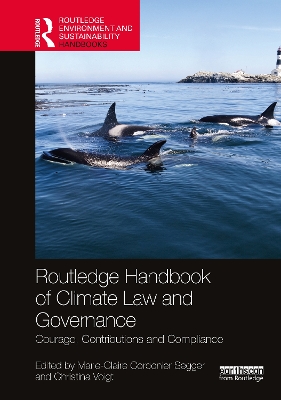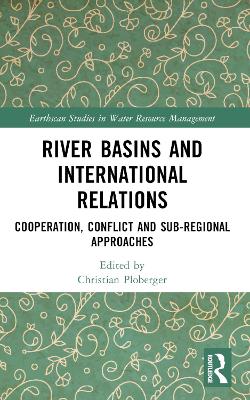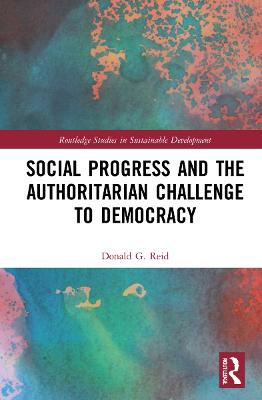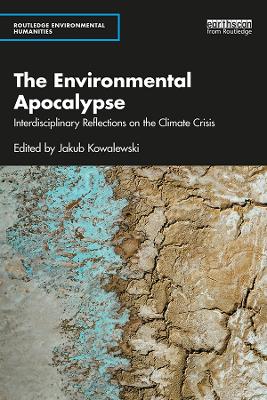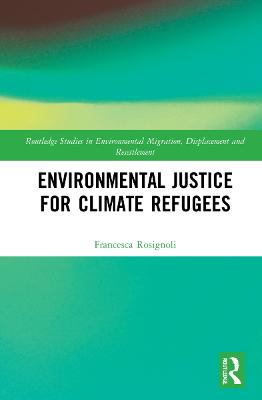UN Human Rights Institutions and the Environment
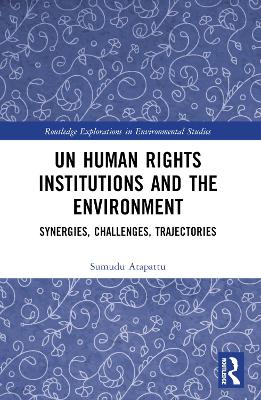 portes grátis
portes grátis
UN Human Rights Institutions and the Environment
Synergies, Challenges, Trajectories
Atapattu, Sumudu
Taylor & Francis Ltd
10/2024
320
Mole
9780367653132
15 a 20 dias
Descrição não disponível.
Contents
Foreword
Acknowledgements
About the author
Abbreviations
Table of cases
Table of treaties and other instruments
Part I
Introduction and overview of international human rights law
1 UN Human Rights Institutions and the Environment: Framing the Issues
1.1 Introduction
1.2 Environmental issues covered
1.2.1 Environmental pollution, environmental degradation and environmental protection
1.2.2 Climate change
1.2.3 Sustainable development and Sustainable Development Goals
1.2.4 Other issues covered
1.3 Methodology
1.4 Outline of the book and overview of chapters
2 An Overview of International Human Rights Law and the Emergence of Environmental Rights
2.1 Introduction
2.2 An overview of International Human Rights Law
2.2.1 International Bill of Rights
2.2.2 Typology of rights
2.3 An overview of human rights institutions
2.3.1 Treaty-based mechanisms
2.3.2 Charter-based mechanisms
2.3.3 Office of the High Commissioner for Human Rights
2.4 Rights affected by environmental degradation
2.4.1 Right to life
2.4.2 Right to health
2.4.3 Rights to food, water and sanitation
2.4.4 Right of self-determination
2.5 Specialized treaties on vulnerable groups
2.6. Emergence of environmental rights and the right to a healthy environment
2.6.1 Articulation of environmental rights
2.6.2 Developments at the UN: The creation of special mandates
2.7 Other global efforts to recognize environmental rights
2.7.1 Draft International Covenant on the Human Right to the Environment
2.7.2 Global Pact for the Environment
2.8 Regional developments
2.9 Developments at the national level
2.10 Conclusion
Part II
Charter-based mechanisms
3 UN Human Rights Council and the Office of the High Commissioner for Human Rights
3.1 Human Rights Council
3.1.1 Introduction and mandate
3.1.2 Universal Periodic Review and working group recommendations
3.1.2.1 Environmental protection
3.1.2.2 Climate change
3.1.2.3 Sustainable development and SDGs
3.1.2.4 Indigenous rights
3.1.2.5 Business enterprises and transnational corporations
3.1.3 Resolutions of the HRC
3.1.3.1 Environmental protection/degradation
3.1.3.2 Climate change
3.1.3.3 Sustainable development and SDGs
3.2 Office of the High Commissioner for Human Rights
3.2.1 Environmental protection/degradation
3.2.2 Climate change
3.2.3 Sustainable development and SDGs
3.3 Conclusion
4 Special Procedures Mandate Holders
4.1 Introduction
4.2 Appointment of a Special Rapporteur on Human Rights and the Environment
4.3 Special Rapporteur on the Implications for Human Rights of the Environmentally Sound Management and Disposal of Hazardous Substances and Wastes
4.4 Independent Expert on Human Rights and the Environment
4.5 Special Rapporteur on Human Rights and Environment
4.5.1 Framework Principles on Human Rights and Environment
4.5.2 David Boyd as Special Rapporteur
4.6 Special Rapporteur on Cultural Rights
4.7 Special Rapporteur on the Right to Food
4.8 Special Rapporteur on Extreme Poverty and Human Rights
4.9 The Working Group on Human Rights and Transnational Corporations and other
Business Enterprises
4.10 Special Rapporteur on Contemporary Forms of Racism, Racial Discrimination,
Xenophobia and Related Intolerance
4.11 Special Rapporteur on Indigenous Peoples
4.12 Special Rapporteur on Climate Change and Human Rights
4.13 Complaint submitted to special mandate holders on Rights of Indigenous Peoples in
addressing climate-forced displacement
4.14 Conclusion
Part III
Treaty-based mechanisms
5 UN Human Rights Committee
5.1 Introduction and mandate
5.2 General comments
5.3 Concluding observations
5.3.1 Environmental pollution, environmental management and natural resource management
5.3.2 Climate change
5.3.3 Indigenous peoples
5.4 Individual communications
5.5 Conclusion
6 Committee on Economic, Social, and Cultural Rights
6.1 Introduction
6.2 General comments
6.3 Concluding observations
6.3.1 Climate change
6.3.2 Environmental pollution, environmental degradation, and environmental impact of mining operations and extractive industries
6.3.3 Sustainable Development and Sustainable Development Goals
6.3.4 Indigenous rights
6.3.5 Human rights defenders
6.4 Resolutions, statements and press releases
6.5 Conclusion
7 Committee on the Elimination of Discrimination Against Women
7.1. Introduction and mandate
7.2. General recommendations
7.2.1 Sustainable development and SDGs
7.2.2 Environmental impact assessments and free, prior and informed consent
7.2.3 Climate change
7.3. Concluding observations
7.3.1 Climate change
7.3.2 Sustainable Development Goals (SDGs)
7.3.3 Environmental pollution
7.3.4 Renewable energy
7.3.5 Women human rights defenders
7.4 Conclusion
8 Committee on the Rights of the Child
8.1 Introduction and mandate
8.2 General Comments
8.2.1 Proposed General Comment on Environment and Climate Change
8.3 Concluding observations
8.3.1 Climate change
8.3.2 Environmental health/pollution/degradation
8.3.3 Children's rights and the business sector
8.3.4 Sustainable Development/SDGs
8.3.5 Other issues discussed/recommendations made
8.4 Individual complaints
8.4.1 Amici curiae brief of Special Rapporteurs
8.4.2 CRC Committee decision
8.5 Conclusion
9 Other Treaty Bodies
9.1 The Committee on the Rights of Persons with Disabilities
9.1.1 General comments
9.1.2 Concluding observations
9.1.3 Disaster risk reduction and climate change
9.1.4 Other relevant provisions
9.2 Committee on the Protection of Rights of All Migrant Workers and Members of their
Families
9.2.1 General comments
9.2.2 Concluding observations
9.3 Committee on the Elimination of Racial Discrimination
9.3.1 General recommendations
9.3.2 Concluding observations
9.4 Conclusion
10 UN Human Rights Institutions and the Environment: Reflections, Challenges, Trajectories
10.1 Introduction
10.2 Principles, guidelines and standards
10.3 General comments
10.4 Individual communications
10.5 Critiques
10.6 Challenges
10.7 Fragmentation, cohesion, or cross-fertilization?
10.8 A research agenda for the future
Index
Foreword
Acknowledgements
About the author
Abbreviations
Table of cases
Table of treaties and other instruments
Part I
Introduction and overview of international human rights law
1 UN Human Rights Institutions and the Environment: Framing the Issues
1.1 Introduction
1.2 Environmental issues covered
1.2.1 Environmental pollution, environmental degradation and environmental protection
1.2.2 Climate change
1.2.3 Sustainable development and Sustainable Development Goals
1.2.4 Other issues covered
1.3 Methodology
1.4 Outline of the book and overview of chapters
2 An Overview of International Human Rights Law and the Emergence of Environmental Rights
2.1 Introduction
2.2 An overview of International Human Rights Law
2.2.1 International Bill of Rights
2.2.2 Typology of rights
2.3 An overview of human rights institutions
2.3.1 Treaty-based mechanisms
2.3.2 Charter-based mechanisms
2.3.3 Office of the High Commissioner for Human Rights
2.4 Rights affected by environmental degradation
2.4.1 Right to life
2.4.2 Right to health
2.4.3 Rights to food, water and sanitation
2.4.4 Right of self-determination
2.5 Specialized treaties on vulnerable groups
2.6. Emergence of environmental rights and the right to a healthy environment
2.6.1 Articulation of environmental rights
2.6.2 Developments at the UN: The creation of special mandates
2.7 Other global efforts to recognize environmental rights
2.7.1 Draft International Covenant on the Human Right to the Environment
2.7.2 Global Pact for the Environment
2.8 Regional developments
2.9 Developments at the national level
2.10 Conclusion
Part II
Charter-based mechanisms
3 UN Human Rights Council and the Office of the High Commissioner for Human Rights
3.1 Human Rights Council
3.1.1 Introduction and mandate
3.1.2 Universal Periodic Review and working group recommendations
3.1.2.1 Environmental protection
3.1.2.2 Climate change
3.1.2.3 Sustainable development and SDGs
3.1.2.4 Indigenous rights
3.1.2.5 Business enterprises and transnational corporations
3.1.3 Resolutions of the HRC
3.1.3.1 Environmental protection/degradation
3.1.3.2 Climate change
3.1.3.3 Sustainable development and SDGs
3.2 Office of the High Commissioner for Human Rights
3.2.1 Environmental protection/degradation
3.2.2 Climate change
3.2.3 Sustainable development and SDGs
3.3 Conclusion
4 Special Procedures Mandate Holders
4.1 Introduction
4.2 Appointment of a Special Rapporteur on Human Rights and the Environment
4.3 Special Rapporteur on the Implications for Human Rights of the Environmentally Sound Management and Disposal of Hazardous Substances and Wastes
4.4 Independent Expert on Human Rights and the Environment
4.5 Special Rapporteur on Human Rights and Environment
4.5.1 Framework Principles on Human Rights and Environment
4.5.2 David Boyd as Special Rapporteur
4.6 Special Rapporteur on Cultural Rights
4.7 Special Rapporteur on the Right to Food
4.8 Special Rapporteur on Extreme Poverty and Human Rights
4.9 The Working Group on Human Rights and Transnational Corporations and other
Business Enterprises
4.10 Special Rapporteur on Contemporary Forms of Racism, Racial Discrimination,
Xenophobia and Related Intolerance
4.11 Special Rapporteur on Indigenous Peoples
4.12 Special Rapporteur on Climate Change and Human Rights
4.13 Complaint submitted to special mandate holders on Rights of Indigenous Peoples in
addressing climate-forced displacement
4.14 Conclusion
Part III
Treaty-based mechanisms
5 UN Human Rights Committee
5.1 Introduction and mandate
5.2 General comments
5.3 Concluding observations
5.3.1 Environmental pollution, environmental management and natural resource management
5.3.2 Climate change
5.3.3 Indigenous peoples
5.4 Individual communications
5.5 Conclusion
6 Committee on Economic, Social, and Cultural Rights
6.1 Introduction
6.2 General comments
6.3 Concluding observations
6.3.1 Climate change
6.3.2 Environmental pollution, environmental degradation, and environmental impact of mining operations and extractive industries
6.3.3 Sustainable Development and Sustainable Development Goals
6.3.4 Indigenous rights
6.3.5 Human rights defenders
6.4 Resolutions, statements and press releases
6.5 Conclusion
7 Committee on the Elimination of Discrimination Against Women
7.1. Introduction and mandate
7.2. General recommendations
7.2.1 Sustainable development and SDGs
7.2.2 Environmental impact assessments and free, prior and informed consent
7.2.3 Climate change
7.3. Concluding observations
7.3.1 Climate change
7.3.2 Sustainable Development Goals (SDGs)
7.3.3 Environmental pollution
7.3.4 Renewable energy
7.3.5 Women human rights defenders
7.4 Conclusion
8 Committee on the Rights of the Child
8.1 Introduction and mandate
8.2 General Comments
8.2.1 Proposed General Comment on Environment and Climate Change
8.3 Concluding observations
8.3.1 Climate change
8.3.2 Environmental health/pollution/degradation
8.3.3 Children's rights and the business sector
8.3.4 Sustainable Development/SDGs
8.3.5 Other issues discussed/recommendations made
8.4 Individual complaints
8.4.1 Amici curiae brief of Special Rapporteurs
8.4.2 CRC Committee decision
8.5 Conclusion
9 Other Treaty Bodies
9.1 The Committee on the Rights of Persons with Disabilities
9.1.1 General comments
9.1.2 Concluding observations
9.1.3 Disaster risk reduction and climate change
9.1.4 Other relevant provisions
9.2 Committee on the Protection of Rights of All Migrant Workers and Members of their
Families
9.2.1 General comments
9.2.2 Concluding observations
9.3 Committee on the Elimination of Racial Discrimination
9.3.1 General recommendations
9.3.2 Concluding observations
9.4 Conclusion
10 UN Human Rights Institutions and the Environment: Reflections, Challenges, Trajectories
10.1 Introduction
10.2 Principles, guidelines and standards
10.3 General comments
10.4 Individual communications
10.5 Critiques
10.6 Challenges
10.7 Fragmentation, cohesion, or cross-fertilization?
10.8 A research agenda for the future
Index
Este título pertence ao(s) assunto(s) indicados(s). Para ver outros títulos clique no assunto desejado.
human rights;environmental degradation;sustainable development;climate change;environmental principles;CEDAW Committee;CRC Committee;ESC Right;Environmental Issues;Concluding Observations;Disaster Risk Reduction;Reduce GHG Emission;CEDAW;SDG;ESCR Committee;Ratify ILO Convention;National Action Plan;Mandate Holders;Disaster Risk Management;Cultural Rights;Energy Policies;Special Procedure Mandate Holders;Slow Onset Events;Working Group Recommended;Habitat III;Lao People's Democratic Republic;Special Rapporteur;Sendai Framework
Contents
Foreword
Acknowledgements
About the author
Abbreviations
Table of cases
Table of treaties and other instruments
Part I
Introduction and overview of international human rights law
1 UN Human Rights Institutions and the Environment: Framing the Issues
1.1 Introduction
1.2 Environmental issues covered
1.2.1 Environmental pollution, environmental degradation and environmental protection
1.2.2 Climate change
1.2.3 Sustainable development and Sustainable Development Goals
1.2.4 Other issues covered
1.3 Methodology
1.4 Outline of the book and overview of chapters
2 An Overview of International Human Rights Law and the Emergence of Environmental Rights
2.1 Introduction
2.2 An overview of International Human Rights Law
2.2.1 International Bill of Rights
2.2.2 Typology of rights
2.3 An overview of human rights institutions
2.3.1 Treaty-based mechanisms
2.3.2 Charter-based mechanisms
2.3.3 Office of the High Commissioner for Human Rights
2.4 Rights affected by environmental degradation
2.4.1 Right to life
2.4.2 Right to health
2.4.3 Rights to food, water and sanitation
2.4.4 Right of self-determination
2.5 Specialized treaties on vulnerable groups
2.6. Emergence of environmental rights and the right to a healthy environment
2.6.1 Articulation of environmental rights
2.6.2 Developments at the UN: The creation of special mandates
2.7 Other global efforts to recognize environmental rights
2.7.1 Draft International Covenant on the Human Right to the Environment
2.7.2 Global Pact for the Environment
2.8 Regional developments
2.9 Developments at the national level
2.10 Conclusion
Part II
Charter-based mechanisms
3 UN Human Rights Council and the Office of the High Commissioner for Human Rights
3.1 Human Rights Council
3.1.1 Introduction and mandate
3.1.2 Universal Periodic Review and working group recommendations
3.1.2.1 Environmental protection
3.1.2.2 Climate change
3.1.2.3 Sustainable development and SDGs
3.1.2.4 Indigenous rights
3.1.2.5 Business enterprises and transnational corporations
3.1.3 Resolutions of the HRC
3.1.3.1 Environmental protection/degradation
3.1.3.2 Climate change
3.1.3.3 Sustainable development and SDGs
3.2 Office of the High Commissioner for Human Rights
3.2.1 Environmental protection/degradation
3.2.2 Climate change
3.2.3 Sustainable development and SDGs
3.3 Conclusion
4 Special Procedures Mandate Holders
4.1 Introduction
4.2 Appointment of a Special Rapporteur on Human Rights and the Environment
4.3 Special Rapporteur on the Implications for Human Rights of the Environmentally Sound Management and Disposal of Hazardous Substances and Wastes
4.4 Independent Expert on Human Rights and the Environment
4.5 Special Rapporteur on Human Rights and Environment
4.5.1 Framework Principles on Human Rights and Environment
4.5.2 David Boyd as Special Rapporteur
4.6 Special Rapporteur on Cultural Rights
4.7 Special Rapporteur on the Right to Food
4.8 Special Rapporteur on Extreme Poverty and Human Rights
4.9 The Working Group on Human Rights and Transnational Corporations and other
Business Enterprises
4.10 Special Rapporteur on Contemporary Forms of Racism, Racial Discrimination,
Xenophobia and Related Intolerance
4.11 Special Rapporteur on Indigenous Peoples
4.12 Special Rapporteur on Climate Change and Human Rights
4.13 Complaint submitted to special mandate holders on Rights of Indigenous Peoples in
addressing climate-forced displacement
4.14 Conclusion
Part III
Treaty-based mechanisms
5 UN Human Rights Committee
5.1 Introduction and mandate
5.2 General comments
5.3 Concluding observations
5.3.1 Environmental pollution, environmental management and natural resource management
5.3.2 Climate change
5.3.3 Indigenous peoples
5.4 Individual communications
5.5 Conclusion
6 Committee on Economic, Social, and Cultural Rights
6.1 Introduction
6.2 General comments
6.3 Concluding observations
6.3.1 Climate change
6.3.2 Environmental pollution, environmental degradation, and environmental impact of mining operations and extractive industries
6.3.3 Sustainable Development and Sustainable Development Goals
6.3.4 Indigenous rights
6.3.5 Human rights defenders
6.4 Resolutions, statements and press releases
6.5 Conclusion
7 Committee on the Elimination of Discrimination Against Women
7.1. Introduction and mandate
7.2. General recommendations
7.2.1 Sustainable development and SDGs
7.2.2 Environmental impact assessments and free, prior and informed consent
7.2.3 Climate change
7.3. Concluding observations
7.3.1 Climate change
7.3.2 Sustainable Development Goals (SDGs)
7.3.3 Environmental pollution
7.3.4 Renewable energy
7.3.5 Women human rights defenders
7.4 Conclusion
8 Committee on the Rights of the Child
8.1 Introduction and mandate
8.2 General Comments
8.2.1 Proposed General Comment on Environment and Climate Change
8.3 Concluding observations
8.3.1 Climate change
8.3.2 Environmental health/pollution/degradation
8.3.3 Children's rights and the business sector
8.3.4 Sustainable Development/SDGs
8.3.5 Other issues discussed/recommendations made
8.4 Individual complaints
8.4.1 Amici curiae brief of Special Rapporteurs
8.4.2 CRC Committee decision
8.5 Conclusion
9 Other Treaty Bodies
9.1 The Committee on the Rights of Persons with Disabilities
9.1.1 General comments
9.1.2 Concluding observations
9.1.3 Disaster risk reduction and climate change
9.1.4 Other relevant provisions
9.2 Committee on the Protection of Rights of All Migrant Workers and Members of their
Families
9.2.1 General comments
9.2.2 Concluding observations
9.3 Committee on the Elimination of Racial Discrimination
9.3.1 General recommendations
9.3.2 Concluding observations
9.4 Conclusion
10 UN Human Rights Institutions and the Environment: Reflections, Challenges, Trajectories
10.1 Introduction
10.2 Principles, guidelines and standards
10.3 General comments
10.4 Individual communications
10.5 Critiques
10.6 Challenges
10.7 Fragmentation, cohesion, or cross-fertilization?
10.8 A research agenda for the future
Index
Foreword
Acknowledgements
About the author
Abbreviations
Table of cases
Table of treaties and other instruments
Part I
Introduction and overview of international human rights law
1 UN Human Rights Institutions and the Environment: Framing the Issues
1.1 Introduction
1.2 Environmental issues covered
1.2.1 Environmental pollution, environmental degradation and environmental protection
1.2.2 Climate change
1.2.3 Sustainable development and Sustainable Development Goals
1.2.4 Other issues covered
1.3 Methodology
1.4 Outline of the book and overview of chapters
2 An Overview of International Human Rights Law and the Emergence of Environmental Rights
2.1 Introduction
2.2 An overview of International Human Rights Law
2.2.1 International Bill of Rights
2.2.2 Typology of rights
2.3 An overview of human rights institutions
2.3.1 Treaty-based mechanisms
2.3.2 Charter-based mechanisms
2.3.3 Office of the High Commissioner for Human Rights
2.4 Rights affected by environmental degradation
2.4.1 Right to life
2.4.2 Right to health
2.4.3 Rights to food, water and sanitation
2.4.4 Right of self-determination
2.5 Specialized treaties on vulnerable groups
2.6. Emergence of environmental rights and the right to a healthy environment
2.6.1 Articulation of environmental rights
2.6.2 Developments at the UN: The creation of special mandates
2.7 Other global efforts to recognize environmental rights
2.7.1 Draft International Covenant on the Human Right to the Environment
2.7.2 Global Pact for the Environment
2.8 Regional developments
2.9 Developments at the national level
2.10 Conclusion
Part II
Charter-based mechanisms
3 UN Human Rights Council and the Office of the High Commissioner for Human Rights
3.1 Human Rights Council
3.1.1 Introduction and mandate
3.1.2 Universal Periodic Review and working group recommendations
3.1.2.1 Environmental protection
3.1.2.2 Climate change
3.1.2.3 Sustainable development and SDGs
3.1.2.4 Indigenous rights
3.1.2.5 Business enterprises and transnational corporations
3.1.3 Resolutions of the HRC
3.1.3.1 Environmental protection/degradation
3.1.3.2 Climate change
3.1.3.3 Sustainable development and SDGs
3.2 Office of the High Commissioner for Human Rights
3.2.1 Environmental protection/degradation
3.2.2 Climate change
3.2.3 Sustainable development and SDGs
3.3 Conclusion
4 Special Procedures Mandate Holders
4.1 Introduction
4.2 Appointment of a Special Rapporteur on Human Rights and the Environment
4.3 Special Rapporteur on the Implications for Human Rights of the Environmentally Sound Management and Disposal of Hazardous Substances and Wastes
4.4 Independent Expert on Human Rights and the Environment
4.5 Special Rapporteur on Human Rights and Environment
4.5.1 Framework Principles on Human Rights and Environment
4.5.2 David Boyd as Special Rapporteur
4.6 Special Rapporteur on Cultural Rights
4.7 Special Rapporteur on the Right to Food
4.8 Special Rapporteur on Extreme Poverty and Human Rights
4.9 The Working Group on Human Rights and Transnational Corporations and other
Business Enterprises
4.10 Special Rapporteur on Contemporary Forms of Racism, Racial Discrimination,
Xenophobia and Related Intolerance
4.11 Special Rapporteur on Indigenous Peoples
4.12 Special Rapporteur on Climate Change and Human Rights
4.13 Complaint submitted to special mandate holders on Rights of Indigenous Peoples in
addressing climate-forced displacement
4.14 Conclusion
Part III
Treaty-based mechanisms
5 UN Human Rights Committee
5.1 Introduction and mandate
5.2 General comments
5.3 Concluding observations
5.3.1 Environmental pollution, environmental management and natural resource management
5.3.2 Climate change
5.3.3 Indigenous peoples
5.4 Individual communications
5.5 Conclusion
6 Committee on Economic, Social, and Cultural Rights
6.1 Introduction
6.2 General comments
6.3 Concluding observations
6.3.1 Climate change
6.3.2 Environmental pollution, environmental degradation, and environmental impact of mining operations and extractive industries
6.3.3 Sustainable Development and Sustainable Development Goals
6.3.4 Indigenous rights
6.3.5 Human rights defenders
6.4 Resolutions, statements and press releases
6.5 Conclusion
7 Committee on the Elimination of Discrimination Against Women
7.1. Introduction and mandate
7.2. General recommendations
7.2.1 Sustainable development and SDGs
7.2.2 Environmental impact assessments and free, prior and informed consent
7.2.3 Climate change
7.3. Concluding observations
7.3.1 Climate change
7.3.2 Sustainable Development Goals (SDGs)
7.3.3 Environmental pollution
7.3.4 Renewable energy
7.3.5 Women human rights defenders
7.4 Conclusion
8 Committee on the Rights of the Child
8.1 Introduction and mandate
8.2 General Comments
8.2.1 Proposed General Comment on Environment and Climate Change
8.3 Concluding observations
8.3.1 Climate change
8.3.2 Environmental health/pollution/degradation
8.3.3 Children's rights and the business sector
8.3.4 Sustainable Development/SDGs
8.3.5 Other issues discussed/recommendations made
8.4 Individual complaints
8.4.1 Amici curiae brief of Special Rapporteurs
8.4.2 CRC Committee decision
8.5 Conclusion
9 Other Treaty Bodies
9.1 The Committee on the Rights of Persons with Disabilities
9.1.1 General comments
9.1.2 Concluding observations
9.1.3 Disaster risk reduction and climate change
9.1.4 Other relevant provisions
9.2 Committee on the Protection of Rights of All Migrant Workers and Members of their
Families
9.2.1 General comments
9.2.2 Concluding observations
9.3 Committee on the Elimination of Racial Discrimination
9.3.1 General recommendations
9.3.2 Concluding observations
9.4 Conclusion
10 UN Human Rights Institutions and the Environment: Reflections, Challenges, Trajectories
10.1 Introduction
10.2 Principles, guidelines and standards
10.3 General comments
10.4 Individual communications
10.5 Critiques
10.6 Challenges
10.7 Fragmentation, cohesion, or cross-fertilization?
10.8 A research agenda for the future
Index
Este título pertence ao(s) assunto(s) indicados(s). Para ver outros títulos clique no assunto desejado.
human rights;environmental degradation;sustainable development;climate change;environmental principles;CEDAW Committee;CRC Committee;ESC Right;Environmental Issues;Concluding Observations;Disaster Risk Reduction;Reduce GHG Emission;CEDAW;SDG;ESCR Committee;Ratify ILO Convention;National Action Plan;Mandate Holders;Disaster Risk Management;Cultural Rights;Energy Policies;Special Procedure Mandate Holders;Slow Onset Events;Working Group Recommended;Habitat III;Lao People's Democratic Republic;Special Rapporteur;Sendai Framework


